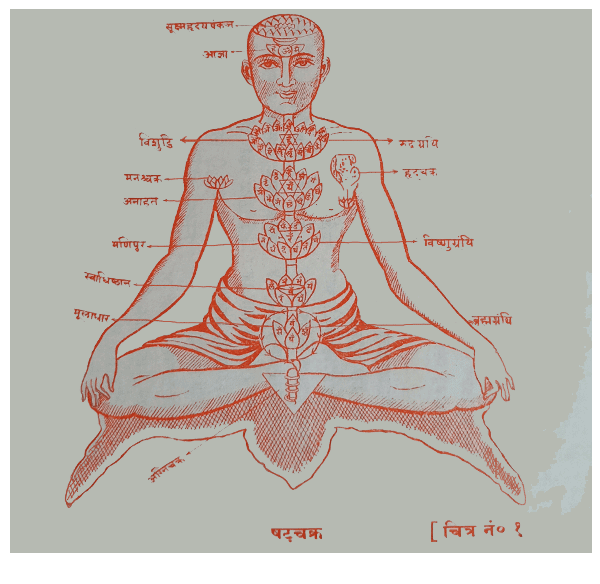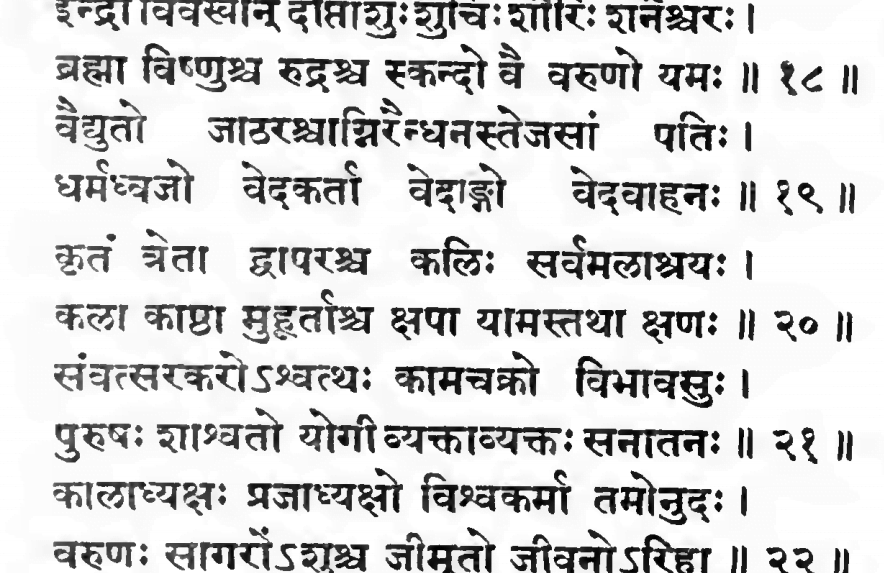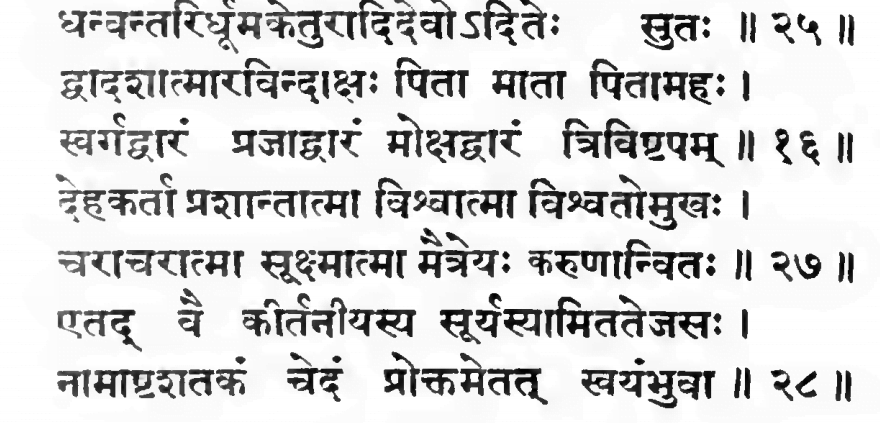Mantras of Surya-namaskar sequence
The construction of each of 12 mantras is the same: syllable “Om”, then one of the names of the Sun in dative case and the word “namas” meaning “I salute”.
Sanskrit, Devanagari and Transliteration
ॐ मित्राय नमः | Oṃ mitrāya namaḥ
ॐ रवये नमः | Oṃ ravaye namaḥ
ॐ सूर्याय नमः | Oṃ sūryāya namaḥ
ॐ भानवे नमः | Oṃ bhānave namaḥ
ॐ भगाय नमः | Oṃ bhagāya namaḥ
ॐ पुष्णे नमः | Oṃ puṣṇe namaḥ
ॐ हिरण्यगर्भाय नमः | Oṃ hiraṇyagarbhāya namaḥ
ॐ मरीचये नमः | Oṃ marīcaye namaḥ
ॐ आदित्याय नमः | Oṃ ādityāya namaḥ
ॐ सावित्रे नमः | Oṃ sāvitre namaḥ
ॐ आर्काय नमः | Oṃ arkāya namaḥ
ॐ भास्कराय नमः | Oṃ bhāskarāya namaḥ
Meaning and morphology of the names of the Sun
In mantras all names of the Sun are in the dative case. You will see them below in nominative case (this is what they look like in the dictionaries):
Mitra — a friend.
There is a debate about from which of the two roots this word originates:
√ मि mi • To spill, to scatter, to establish.
√ मिद् mid • To be oily, to be delicate and to love.
Ravi — roaring.
√ रु [ru] • To cry, to bawl, to roar, to sound.
Surya — a crater.
√ सू sū • To set in motion, to give an impetus, to encourage, to animate, to create.
Bhaanu — splendid, shining.
√ भा bhā • To shine, to arise, to become visible
Bhaga — a vested with fate, fortunate.
√ भज् bhaj • To to serve, to give.
Puushan — a breadwinner.
√ पुष् puṣ • To nourish, to raise, to cultivate, to nurse.
Hiran’ya-garbha — a golden embryo.
हिरण्य • golden गर्भ • embryo.
√ गॄ • To sound, to urge.
Mariichi - a flame, a ray.
√ मृ mṛ • To die.
Aadit’ya — what belongs to infinity.
The noun of belonging, that comes from the noun “aditi”, that formed by prefix अ a • negation and root √ दो do • split into parts.
Savitar — a creator, maker.
√ सू sū • To set in motion, give an impetus, to encourage, to revive, to create.
Арка — a respected, worthy of worship.
√ अर्च् arc • force to worship, to inspire respect.
Bhaa-s-kaara — that leads to enlightenment (knowledge).
√ भा bhā •To glow, to appear, to become visible.
√ कृ kṛ • to do, каара — doer - someone for does something.
The ultimate meaning of each mantra is traditionally passed down from the teacher to the student.
The first mentions of Surya-Namaskar sequence
Some of the "stretching" movements of Surya-Namaskar complex may originate from the sun worship practice. However, its inclusion into the system of yoga practices was unknown until the XX century. The only mention of the Surya-Namaskar term in the mediaeval texts is a warning not to practise it on the ground, since this kind of repeated performance could cause bodily injuries. It implies that the complex was known before the XX century."
The modern version of the Surya-namaskar sequence is known with accompaniment of mantras — names of the Sun. If the complex itself could be considered as modern one, the technique of performing mantras has ancient roots. The exact date is unknown, but the earliest known reference to the name of the Sun is in “Mahabharata”.
Also, addressing the states of the Sun is known as addressing personifications of the psychological experiences of a person from primary sources of yoga:
Who knows that, leaves this world,
Who attains this Atman, that consists of food,
Who attains this Atman, that consist of breath,
Who attains this Atman, that consists of mind,
Who attains this Atman, that consist of recognition,
Who attains this Atman, that consist of pleasure”
“Taittipiya Upanishada”.
Mantra as a technique
The word “mantra” comes from the root “man” — “think” and the suffix “tra” that creates a noun meaning a tool or a place of action of the root. Mantra means literally a “tool for thinking”.
The task of a mantra is to awaken a chosen psychological state that is associated with mantra in someone who practises it.
Mantras should not be confused with prayers or forms designed for verbal self-guidance, so they might not have semantic load (or may have).
A tantric view on Sanskrit grammar also describes a connection between sounds and chakras — the energetic and emotional center of the human.
There are images, where each letter of Sanskrit is placed on different areas of chakras (referring to different states of being). This connection is explained in many primary sources, where chakras are mentioned (Chakra-kaumudi. Yoga-vishnaya, Shat-chakra-nirupana, etc.). Hence, not only pronunciation of the word is tightly connected to an action and a state of being, but also pronunciation of the sound is connected to certain feelings.

Names of the Sun in Magabharata


One hundred eight names of the Sun are listed in the third chapter “Aranyaka-parva” book from the epos of “Magabharata”.
“I will tell thee everything in detail, And, O illustrious one, listen to the one hundred and eight names (of the sun) as they were disclosed of old by Dhaumya to the high-souled son of Pritha. Dhaumya said, ‘Surya, Aryaman, Bhaga, Twastri, Pusha, Arka, Savitri. Ravi, Gabhastimat, Aja, Kala, Mrityu, Dhatri, Prabhakara, Prithibi, Apa, Teja, Kha, Vayu, the sole stay, Soma, Vrihaspati, Sukra, Budha, Angaraka, Indra, Vivaswat, Diptanshu, Suchi, Sauri, Sanaichara, Brahma, Vishnu, Rudra, Skanda, Vaisravana, Yama, Vaidyutagni, Jatharagni, Aindhna, Tejasampati, Dharmadhwaja, Veda-karttri, Vedanga, Vedavahana, Krita, Treta, Dwapara, Kali, full of every impurity, Kala, Kastha, Muhurtta, Kshapa, Yama, and Kshana; Samvatsara-kara, Aswattha, Kalachakra, Bibhavasu, Purusha, Saswata, Yogin, Vyaktavyakta, Sanatana, Kaladhyaksha, Prajadhyaksha, Viswakarma, Tamounda, Varuna, Sagara, Ansu, Jimuta, Jivana, Arihan, Bhutasraya, Bhutapati, Srastri, Samvartaka, Vanhi, Sarvadi, Alolupa, Ananta, Kapila, Bhanu, Kamada, Sarvatomukha, Jaya, Visala, Varada, Manas, Suparna, Bhutadi, Sighraga, Prandharana, Dhanwantari, Dhumaketu, Adideva, Aditisuta, Dwadasatman, Aravindaksha, Pitri, Matri, Pitamaha, Swarga-dwara, Prajadwara, Mokshadwara, Tripistapa, Dehakarti, Prasantatman, Viswatman, Viswatomukha,
Characharatman, Sukhsmatman, the merciful Maitreya. These are the hundred and eight names of Surya of immeasurable energy, as told by the self-create (Brahma). For the acquisition of prosperity, I bow down to thee, O Bhaskara, blazing like unto gold or fire, who is worshipped of the gods and the Pitris and the Yakshas, and who is adored by Asuras, Nisacharas, and Siddhas. He that with fixed attention reciteth this hymn at sunrise, obtaineth wife and offspring and riches and the memory of his former existence, and by reciting this hymn a person attaineth patience and memory. Let a man concentrating his mind, recite this hymn. By doing so, he shall be proof against grief and forest-fire and ocean and every object of desire shall be his.”

